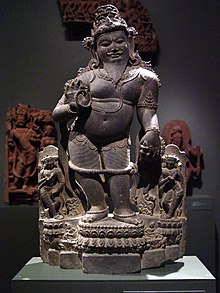ਸੰਗਮ ਸਾਹਿਤ
ਦਿੱਖ

ਸੰਗਮ ਸਾਹਿਤ ਉਸ ਸਾਹਿਤ ਨੂੰ ਕਿਹਾ ਜਾਂਦਾ ਹੈ ਜਿਸਦੀ ਰਚਨਾ 300 ਈਸਵੀ ਪੂਰਵ ਤੋਂ 300 ਈਸਵੀ ਦੌਰਾਨ ਤਾਮਿਲ ਭਾਸ਼ਾ ਵਿੱਚ ਪ੍ਰਾਚੀਨ ਭਾਰਤ ਸਮੇਂ ਕੀਤੀ ਗਈ ਸੀ।[1][2][3][4][5] ਇਸ ਸੰਗਹ੍ਰਿ ਵਿੱਚ 2381 ਕਵਿਤਾਵਾਂ ਹਨ ਜੋ ਕਿ 473 ਕਵੀਆਂ ਦੁਆਰਾ ਤਿਆਰ ਕੀਤੀਆਂ ਗਈਆਂ ਹਨ। ਇਨ੍ਹਾਂ ਵਿੱਚੋਂ 102 ਕਵੀ ਅਗਿਆਤ ਹਨ।[6][7][8][9][10][11][12][13][14][15]
ਹਵਾਲੇ
[ਸੋਧੋ]- ↑ There are some who claim earlier dates (up to 600 BCE). Others cite as late as 200 BCE. The date of 300 BCE may represent a middle-of-the road consensus view; e.g. see the well-received textbook Ancient India, Upinder Singh, 2009, p. 15. However, it is quite likely that the songs existed in oral tradition well before this date.
- ↑ Kamil Veith Zvelebil, Companion Studies to the History of Tamil Literature, p. 12
- ↑ K.A. Nilakanta Sastry, A History of South India, OUP (1955) p. 105
- ↑ Classical Tamil
- ↑ T.S. Subramanian (2009-07-10). "Jain History of Tamil Nadu vandalised". Retrieved 2011-06-03.
The six Tamil-Brahmi inscriptions of the 2nd century B.C. on the brow of five caverns on the Kazhugumalai hill near Mankulam, 38 km from Madurai, are the most ancient ones in Tamil Nadu and establish the historical facts that the Pandyan king Nedunchezhiyan ruled in the 2nd century B.C. and that Sangam literature dates back to the same period.
- ↑ George L. Hart III, The Poems of Ancient Tamil, U of California P, 1975.
- ↑ Irayanaar Agapporul dated to c 750 AD first mentioned the Sangam legends. An inscription of the early tenth century AD mentions the achievements of the early Pandya kings of establishing a Sangam in Madurai. See K.A. Nilakanta Sastry, A History of South India, OUP (1955) p. 105
- ↑ "The latest limit of Ettutokai and Pattupattu may be placed around 700 AD...." – Vaiyapuri Pillai, History of Tamil language and literature p. 38.
- ↑ "...the Tamil language of these brief records achieved a flowering during the first centuries of the Common Era, culminating in the emergence of a poetic corpus of very high quality [...] To this corpus the name sangam poetry was added soon afterwards...." Burton Stein, A History of India (1998), Blackwell p. 90.
- ↑ The only religious poems among the shorter poems occur in paripaatal. The rest of the corpus of Sangam literature deals with human relationship and emotions. See K.A. Nilakanta Sastri, A History of South India, OUP (1955) pp. 330–335
- ↑ Chera, Chola, Pandya: Using Archaeological Evidence to Identify the Tamil Kingdoms of Early Historic South India – Abraham, Shinu Anna, Asian Perspectives – Volume 42, Number 2, Fall 2003, pp. 207–223 University of Hawaii Press
- ↑ Morality and Ethics in Public Life by Ravindra Kumar p.92
- ↑ Essays on Indian Society by Raj Kumar p.71
- ↑ Zvelebil, Kamil V., Tamil Literature, 1975, E J Brill, Leiden, p 108
- ↑ Ramanujan, A.K., Interior Landscape, 1967, Afterword, p115.
